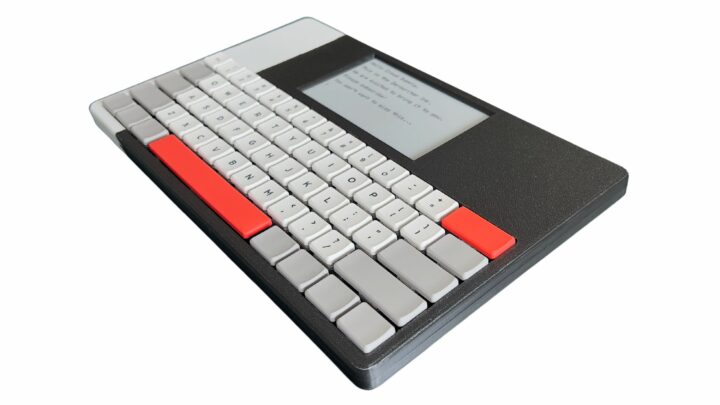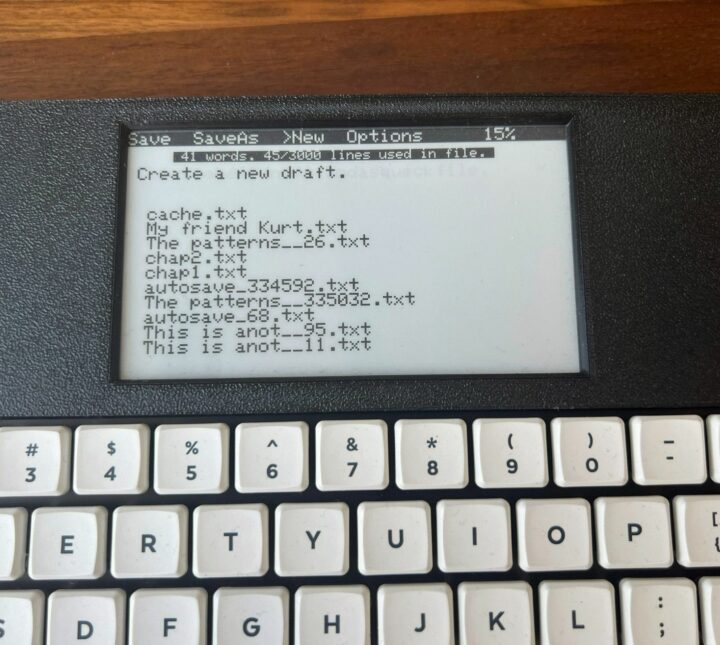Zerowriter Ink is an e-paper word processor for writers interested in an open-source, distraction-free writing tool built around the ESP32-S3 wireless microcontroller. It features a customizable, mechanical keyboard with low-profile Kailh Choc switches and a second-edition Inkplate 5 e-paper display from Soldered Electronics.
The Zerowriter Ink is a compact, dedicated writing tool that can be tossed in a backpack and taken on the road. It is designed as an open-source, customizable alternative to other portable word processors like the Alphasmart Neo and the Pomera DM30. It builds on the first ZeroWriter project but comes fully assembled.
The keyboard is hot-swappable, with a US-English layout and printed legends. The onboard Inkplate 5 e-paper display is powered by an ESP32-S3 microcontroller with support for Wi-Fi 4 and BLE 4. It also comes with a 5,000mAh LiPo battery that can last for several weeks of daily use or a month of standby on a single charge. It looks a bit like the ESP-powered M5Stack Cardputer but has a larger more usable display.
Zerowriter Ink specifications:
- Display – Inkplate 5 v2
- 5.2-inch display with a 1280 x 720 widescreen resolution
- Refresh Rate – Full refresh in 1.02s and partial refresh in 0.19s
- Storage – microSD card
- Keyboard – Hot-swappable, 60% mechanical keyboard with Kailh Choc low-profile switches and keycaps
- USB – USB-C port for file transfers, programming, and charging
- Battery – 5,000mAh LiPo battery
- Dimensions – 295 x 180 x 15 mm
The Zerowriter Ink ESP32-S3-based e-paper word processor features a high-contrast, high-resolution e-paper screen that is readable in sunlight and “eye-friendly.” The firmware is written in Arduino and currently supports basic writing and editing features. Files are stored on the included microSD card and can be managed on the device. There are optional session tools for tracking word count, total writing time, and other milestones. Additional software features currently in development include a no-code keyboard layout editor, keyboard shortcuts, password-protect, and a persistent reference notepad.
The project aims to be completely open-source, and all hardware design files and source code will be published on GitHub before shipping starts. A getting started guide will be included in each package and less tech-savvy writers won’t be stuck trying to figure out how the typewriter works.
The Zerowriter Ink campaign is live on Crowd Supply and is already halfway to its funding goal of $30,000. You can get a ZeroWriter Ink typewriter with a USB C-to-A cable for $199. There is a shipping fee of $8 within the United States and $18 to the rest of the world. Orders are expected to ship by February next year.

Tomisin is a writer specializing in hardware product reviews, comparisons, and explainers. He is very passionate about small form factor and single-board computers.
Support CNX Software! Donate via cryptocurrencies, become a Patron on Patreon, or purchase goods on Amazon or Aliexpress






